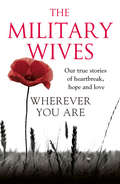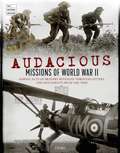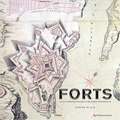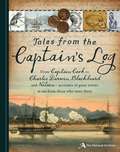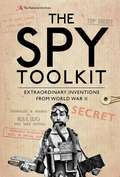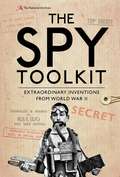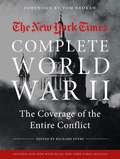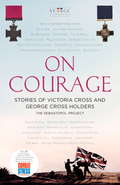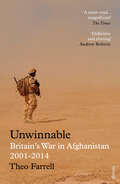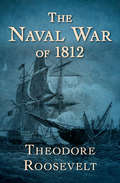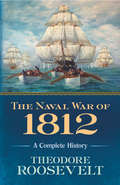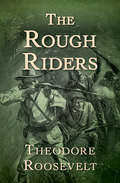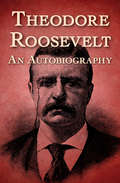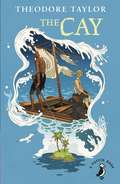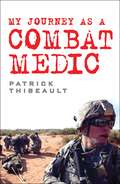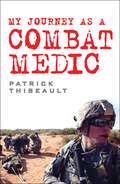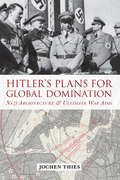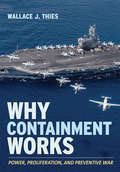- Table View
- List View
Wherever You Are: Our True Stories Of Heartbreak, Hope And Love
by The Military WivesFrom the moment the Military Wives sang together on BBC Two’s The Choir, their lives changed forever. Their journey entranced the nation, and their story moved millions.
Audacious Missions of World War II: Daring Acts of Bravery Revealed Through Letters and Documents from the Time
by The National ArchivesWinning World War II was about more than military force. It required guile, and tremendous acts of bravery by Special Forces and intelligence operatives who had the odds stacked against them. Using hundreds of documents and images from The National Archives, including some that have never been seen in print before, this book reveals some of World War II's most audacious missions.These include Operation Anthropoid, the plot to assassinate SS General Reinhard Heydrich in Czechoslovakia in 1942, Operation Chariot, the attempt to damage the mighty German warship Tirpitz while she was in dock in St-Nazaire in France; and Operation Mincemeat, a complex plot whereby a corpse, replete with documentation designed to mislead the enemy, was dropped in southern Spain to spread misinformation.
Audacious Missions of World War II: Daring Acts of Bravery Revealed Through Letters and Documents from the Time
by The National ArchivesWinning World War II was about more than military force. It required guile, and tremendous acts of bravery by Special Forces and intelligence operatives who had the odds stacked against them. Using hundreds of documents and images from The National Archives, including some that have never been seen in print before, this book reveals some of World War II's most audacious missions.These include Operation Anthropoid, the plot to assassinate SS General Reinhard Heydrich in Czechoslovakia in 1942, Operation Chariot, the attempt to damage the mighty German warship Tirpitz while she was in dock in St-Nazaire in France; and Operation Mincemeat, a complex plot whereby a corpse, replete with documentation designed to mislead the enemy, was dropped in southern Spain to spread misinformation.
Forts: An illustrated history of building for defence
by The National ArchivesEver since humans began to live together in settlements they have felt the need to organise some kind of defence against potentially hostile neighbours. Many of the earliest city states were built as walled towns, and during the medieval era, stone castles were built both as symbols of the defenders' strength and as protection against potential attack. The advent of cannon prompted fortifications to become lower, denser and more complex, and the forts of the eighteenth and nineteenth centuries could appear like snowflakes in their complexity and beautiful geometry. Without forts, the history of America could have taken a very different course, pirates could have sailed the seas unchecked, and Britain itself could have been successfully invaded. This book explains the history of human fortifications, and is beautifully illustrated using photographs, plans, drawings and maps to explain why they were built, their various functions and their immense historical legacy in laying the foundations of empire.
Forts: An illustrated history of building for defence
by The National ArchivesEver since humans began to live together in settlements they have felt the need to organise some kind of defence against potentially hostile neighbours. Many of the earliest city states were built as walled towns, and during the medieval era, stone castles were built both as symbols of the defenders' strength and as protection against potential attack. The advent of cannon prompted fortifications to become lower, denser and more complex, and the forts of the eighteenth and nineteenth centuries could appear like snowflakes in their complexity and beautiful geometry. Without forts, the history of America could have taken a very different course, pirates could have sailed the seas unchecked, and Britain itself could have been successfully invaded. This book explains the history of human fortifications, and is beautifully illustrated using photographs, plans, drawings and maps to explain why they were built, their various functions and their immense historical legacy in laying the foundations of empire.
Tales from the Captain's Log
by The National ArchivesFor centuries, ships' commanders kept journals that recorded their missions. These included voyages of discovery to unknown lands, engagements in war and sea and general trade. Many of their logs, diaries and letters were lodged at The National Archives and give a vivid picture of the situations that they encountered. Entries range from Captain James Cook's notes of his discovery of the South Pacific and Australia, to logs of the great naval battles, such as Trafalgar and the Battle of the Nile. From the ships that attempted to stop piracy in the Caribbean, to the surgeons who recorded the health of the men they tended and naturalists who noted the exotic plants and animals they encountered, comes a fascinating picture of life at sea, richly illustrated with maps, drawings and facsimile documents found alongside the logs in the archives.
Tales from the Captain's Log
by The National ArchivesFor centuries, ships' commanders kept journals that recorded their missions. These included voyages of discovery to unknown lands, engagements in war and sea and general trade. Many of their logs, diaries and letters were lodged at The National Archives and give a vivid picture of the situations that they encountered. Entries range from Captain James Cook's notes of his discovery of the South Pacific and Australia, to logs of the great naval battles, such as Trafalgar and the Battle of the Nile. From the ships that attempted to stop piracy in the Caribbean, to the surgeons who recorded the health of the men they tended and naturalists who noted the exotic plants and animals they encountered, comes a fascinating picture of life at sea, richly illustrated with maps, drawings and facsimile documents found alongside the logs in the archives.
The Spy Toolkit: Extraordinary inventions from World War II
by The National Archives Dr Stephen TwiggeSpies claim that theirs is the second oldest profession. Secret agents across time have had the same key tasks: looking and listening, getting the information they need and smuggling it back home. Over the course of human history, some amazingly complex and imaginative tools have been created to help those working under the cloak of supreme secrecy.During the Second World War, British undercover agents were the heroes behind the scenes, playing a dangerous and sometimes deadly game – risking all to gather intelligence about their enemies. What did these agents have in their toolkits? What ingenious spy gadgets did they have up their sleeves? What devious tricks did they deploy to avoid detection? From the ingenious to the amusing, this highly visual book delves into espionage files that were long held top secret, revealing spycraft in action.
The Spy Toolkit: Extraordinary inventions from World War II (PDF)
by The National Archives Dr Stephen TwiggeSpies claim that theirs is the second oldest profession. Secret agents across time have had the same key tasks: looking and listening, getting the information they need and smuggling it back home. Over the course of human history, some amazingly complex and imaginative tools have been created to help those working under the cloak of supreme secrecy.During the Second World War, British undercover agents were the heroes behind the scenes, playing a dangerous and sometimes deadly game – risking all to gather intelligence about their enemies. What did these agents have in their toolkits? What ingenious spy gadgets did they have up their sleeves? What devious tricks did they deploy to avoid detection? From the ingenious to the amusing, this highly visual book delves into espionage files that were long held top secret, revealing spycraft in action.
The New York Times Complete World War II: The Coverage of the Entire Conflict
by The New York TimesExperience the history, politics, and tragedy of World War II as you've never seen it before with original, often firsthand daily reportage of The New York Times, our country's newspaper of record.The Times' complete coverage of World War II is now available for the first time in this unique package. Hundreds of the most riveting articles from the archives of the Times including firsthand accounts of major events and little-known anecdotes have been selected for inclusion in The New York Times: The Complete World War II. The book covers the biggest battles of the war, from the Battle of the Bulge to the Battle of Iwo Jima, as well as moving stories from the home front and profiles of noted leaders and heroes such as Winston Churchill and George Patton.A respected World War II historian and writer, editor Richard Overy guides readers through the articles, putting the events into historical context. The enclosed DVD-ROM gives access to more day-by-day coverage of World War II in The New York Times -- from the invasion of Poland to V-J day with access to over 98,000 articles.Beautifully designed and illustrated with hundreds of maps and historical photographs, it's the perfect gift for any war, politics, or history buff.
NEW YORK TIMES COMPLETE WORLD WAR II: The Coverage of the Entire Conflict
by The New York TimesExperience the history, politics, and tragedy of World War II as you've never seen it before with original, often firsthand daily reportage of The New York Times, our country's newspaper of record.The Times' complete coverage of World War II is now available for the first time in this unique package. Hundreds of the most riveting articles from the archives of the Times including firsthand accounts of major events and little-known anecdotes have been selected for inclusion in The New York Times: The Complete World War II. The book covers the biggest battles of the war, from the Battle of the Bulge to the Battle of Iwo Jima, as well as moving stories from the home front and profiles of noted leaders and heroes such as Winston Churchill and George Patton.A respected World War II historian and writer, editor Richard Overy guides readers through the articles, putting the events into historical context. The enclosed DVD-ROM gives access to more day-by-day coverage of World War II in The New York Times -- from the invasion of Poland to V-J day with access to over 98,000 articles.Beautifully designed and illustrated with hundreds of maps and historical photographs, it's the perfect gift for any war, politics, or history buff.
On Courage: Stories of Victoria Cross and George Cross Holders
by The Sebastopol ProjectOn Courage is a collection of twenty-eight moving and inspirational stories of valour displayed by recipients of the Victoria Cross and George Cross. WITH CONTRIBUTIONS FROM:Alexander Armstrong, Baroness Hale, Bear Grylls, Bill Beaumont, Bobby Charlton, Katherine Grainger, Kelly Holmes, Derek Jacobi, Eddie Redmayne, Frank Bruno, Geoffrey Palmer, Jeremy Irons, Joanna Kavenna, Joanna Lumley, John Simpson, Joseph Calleja, Julian Fellowes, Kate Adie, Ken Dodd, Margaret MacMillan, Mark Pougatch, Mary Berry, Michael Whitehall and Jack Whitehall, Miranda Hart, Richard Chartres, Tom Ward, Will Greenwood, and Willie Carson.From RAF flight engineer Norman Jackson, who climbed out onto the wing of a Lancaster bomber in flight to put out a fire, using a twisted parachute as a rope, on the night his first child was born; children's writer turned Assistant Section Officer Noor Inayat-Khan, who was the first female operator to infiltrate occupied France and refused to abandon what had become the most dangerous post in the country; to Irish seaman and Antarctic explorer Tom Crean, who struck out alone for a supply depot during Captain Scott's expedition to the South Pole to save the life of his ailing companion, these courageous men and women are an inspiration to us all. Written by leading historians and authors Tom Bromley, Saul David, Paul Garlington, James Holland and Dr Spencer Jones, these incredible accounts tell of the recipients' determination and selfless actions in times of war. Each story is introduced by a public figure, including Mary Berry, Bear Grylls, Sir Bobby Charlton, Joanna Lumley, Eddie Redmayne and the late Sir Ken Dodd.
Tank Spotter’s Guide (General Military Ser.)
by The Tank MuseumInvented during World War I to break the grim deadlock of the Western Front trenches, tanks have gone on to revolutionise warfare. From the lightning Blitzkrieg assaults of World War II to the great battles in the Middle Eastern desert and the largest ever tank battles on the Eastern Front, tanks have become one of the key components of the 'combined arms' philosophy of warfare. This pocket guide gives the reader all of the essential information on 40 of history's premiere tanks, including the Tiger, Sherman, Panther and M1A1 Abrams. Each tank is presented with a detailed drawing to aid recognition.
Tank Spotter’s Guide
by The Tank MuseumInvented during World War I to break the grim deadlock of the Western Front trenches, tanks have gone on to revolutionise warfare. From the lightning Blitzkrieg assaults of World War II to the great battles in the Middle Eastern desert and the largest ever tank battles on the Eastern Front, tanks have become one of the key components of the 'combined arms' philosophy of warfare. This pocket guide gives the reader all of the essential information on 40 of history's premiere tanks, including the Tiger, Sherman, Panther and M1A1 Abrams. Each tank is presented with a detailed drawing to aid recognition.
Unwinnable: Britain’s War in Afghanistan, 2001–2014 (Everyman's Library CLASSICS)
by Theo FarrellChosen as a Book of the Year by the Sunday Times and the Evening Standard'Authoritative and provocative… For its range and breadth, it is a tour de force and a must read' Evening StandardIt could have been a very different story.British and US forces could have successfully withdrawn from Afghanistan in 2002, having done the job they set out to do: to defeat al-Qaeda and stop it from launching further terrorist attacks against the West. Instead, British troops became part of a larger international effort to stabilise the country. Yet over the following thirteen years the British military paid a heavy price for their presence in Helmand province; and when Western troops departed from Afghanistan in 2014, they had failed to stop a Taliban resurgence. In this magisterial study, Theo Farrell explains the origins and causes of the war, providing fascinating insight into the British government’s reaction to 9/11 and the steps that led the British Army to Helmand. He details the specific campaigns and missions over the subsequent years, revealing how the military’s efforts to create a strategy for success were continually undermined by political realities in Kabul and back home. And he demonstrates conclusively that the West's failure to understand the dynamics of local conflict in the country, and to tackle Afghan government corruption, meant that the war was unwinnable.Drawing on unprecedented access to military reports and government documents, as well as hundreds of interviews with Western commanders, senior figures in the Taliban, Afghan civilians and British politicians, Unwinnable is an extraordinary work of scholarship. Its depth of analysis, scope and authority make it the definitive history of Britain’s War in Afghanistan.
The Naval War of 1812
by Theodore RooseveltTheodore Roosevelt’s landmark work of military history: The definitive account of the War of 1812. First published in 1882, The Naval War of 1812 established Theodore Roosevelt’s reputation as a noteworthy historian and scholar at just twenty-three years old. Four years later, the US Navy ordered copies of the book to be kept on every ship. With exhaustive research into all levels of the conflict, Roosevelt presented an illuminating account of the political grievances between the United States and Britain, as well as the virtues and weaknesses of ship commanders on both sides. He demonstrated an impressive understanding of naval technology, detailing weaponry and ship designs and their effects on the outcome of each battle. Refuting previous accounts of the war, Roosevelt bluntly criticized America’s military weaknesses in the face of the British fleet. Though The Naval War of 1812 initially stirred controversy in political circles, Roosevelt’s persuasive analysis inspired a movement to strengthen our national defense. This ebook has been professionally proofread to ensure accuracy and readability on all devices.
The Naval War of 1812: A Complete History
by Theodore RooseveltAlthough only 23 years old at the time of publication, Theodore Roosevelt made his mark as a military scholar with this detailed analysis of naval combat between the United States and Great Britain from 1812–15. Engagingly written and comprehensively researched, The Naval War of 1812 exercised considerable influence on the formation of the modern American Navy and remains a cornerstone work in its field.Drawing upon official documents, letters, and histories, Roosevelt portrays the political and social atmosphere in the United States and Great Britain prior to the war, taking particular note of America's unpreparedness. He then presents a balanced year-by-year chronicle of the war's progression on the Atlantic Ocean and the American lakes. Unlike prior histories, Roosevelt's account offers impartial assessments of the relative strengths and weaknesses of both sides. Four years after publication, the U.S. Navy ordered that a copy be placed on every ship, and it remains standard reading at the Naval Academy. The book contributed to Roosevelt's appointment as Assistant Secretary of the Navy and his role in the navy's development and modernization, resulting in a significant step toward America's rise as a world power.
The Rough Riders
by Theodore RooseveltTheodore Roosevelt’s bestselling memoir chronicling the 1st United States Volunteer Cavalry and its victory at San Juan Hill in the Spanish-American War. Yearning to join the fight for Cuban independence in the Spanish–American War, Theodore Roosevelt and Col. Leonard Wood formed the 1st United States Volunteer Cavalry. They enlisted a motley crew from all walks of life, from cowboys and frontiersmen to Ivy League graduates. These 1,250 men became known as the Rough Riders. After training in San Antonio, Texas, they set out for the tropical jungles of Cuba. As they grappled with hunger, malaria, and occasional defeat, their many battles with the Spanish Army culminated in the death-defying charge to victory at San Juan Hill. Through it all, Roosevelt kept a pocket diary in which he made daily entries about his experiences and the men who fought beside him. Imbued with his trademark vigor and certainty of purpose, Roosevelt’s firsthand account of this historic campaign paints a vivid picture of the rugged, independent spirit that came to define American heroism. This ebook has been professionally proofread to ensure accuracy and readability on all devices.
Theodore Roosevelt
by Theodore RooseveltThe firsthand account of the life of adventurer, scholar, war hero, and twenty-sixth president of the United States Theodore Roosevelt.There must be the keenest sense of duty, and with it must go the joy of living. Here, in his own words, Theodore Roosevelt recounts his remarkable journey from a childhood plagued with illnesses to the US presidency and beyond. With candor and vivid detail, this personal account describes a life guided by a restless intelligence, a love for adventure, and an unflagging duty to his country. Roosevelt sheds light on his wide array of roles, from New York police commissioner, where he waged a battle against corruption, to cattle rancher in the Dakotas to assistant secretary of the US Navy under William McKinley to leader of the legendary Rough Riders at the outbreak of the Spanish–American War, when he led the 1st United States Volunteer Cavalry to victory in the Battle of San Juan Hill. These extraordinary accomplishments earned Roosevelt national fame and set the stage for his ascent to the White House. As twenty-sixth president of the United States, he ushered in the Progressive Era with his domestic policies, such as the Square Deal, and trust-busting of monopolies, such as Standard Oil. He was a war hero, scholar, statesman, adventurer, and Nobel Peace Prize winner. Theodore Roosevelt: An Autobiography provides unique insight into the truly remarkable life of one of America’s most beloved presidents. This ebook has been professionally proofread to ensure accuracy and readability on all devices.
Theodore Roosevelt: An Autobiography
by Theodore RooseveltTheodore Roosevelt: An Autobiography recounts the decorated soldier and esteemed politician's life from his earliest remembrances through his years as a Rough Rider and his eight years in the White House.Be it mystery, romance, drama, comedy, politics, or history, great literature stands the test of time. ClassicJoe proudly brings literary classics to today's digital readers, connecting those who love to read with authors whose work continues to get people talking. Look for other fiction and non-fiction classics from ClassicJoe.
The Cay (A Puffin Book #38)
by Theodore Taylor Kenny McKendryA tense and compulsive survival story of a young boy and an old man adrift on the ocean, then marooned on a tiny, deserted island. It is also a fascinating study of the relationship between Phillip, white, American, and influenced by his mother's prejudices, and the black man upon whom Phillip's life depends.
My Journey as a Combat Medic: From Desert Storm to Operation Enduring Freedom
by Patrick ThibeaultPatrick Thibeault has served in the US Army in various capacities since the 1990s, originally training as a Airborne soldier before specialising as a combat medic. My Journey as a Combat Medic covers his original training and deployment before providing a look at the roles he's since played in the US Army's forces, including his recent deployment to Afghanistan. It is a no-holds bar look at the modern medic in the US Army, allowing us a glimpse at the training as a soldier and as a specialist, as well as deployment and front line duties and the impact of service on civilian life, including an honest look at PTSD, from the author's own personal experience. Rather than a technical manual, My Journey as a Combat Medic is a detailed first hand account, concluding with a letter to new medics, providing a career's worth of advice and knowledge as they begin their journeys.
My Journey as a Combat Medic: From Desert Storm to Operation Enduring Freedom
by Patrick ThibeaultPatrick Thibeault has served in the US Army in various capacities since the 1990s, originally training as a Airborne soldier before specialising as a combat medic. My Journey as a Combat Medic covers his original training and deployment before providing a look at the roles he's since played in the US Army's forces, including his recent deployment to Afghanistan. It is a no-holds bar look at the modern medic in the US Army, allowing us a glimpse at the training as a soldier and as a specialist, as well as deployment and front line duties and the impact of service on civilian life, including an honest look at PTSD, from the author's own personal experience. Rather than a technical manual, My Journey as a Combat Medic is a detailed first hand account, concluding with a letter to new medics, providing a career's worth of advice and knowledge as they begin their journeys.
Hitler's Plans for Global Domination: Nazi Architecture and Ultimate War Aims
by Jochen ThiesWhat did Hitler really want to achieve: world domination. In the early twenties, Hitler was working on this plan and from 1933 on, was working to make it a reality. During 1940 and 1941, he believed he was close to winning the war. This book not only examines Nazi imperial architecture, armament, and plans to regain colonies but also reveals what Hitler said in moments of truth. The author presents many new sources and information, including Hitler’s little known intention to attack New York City with long-range bombers in the days of Pearl Harbor.
Why Containment Works: Power, Proliferation, and Preventive War (Cornell Studies in Security Affairs)
by Wallace J. ThiesWhy Containment Works examines the conduct of American foreign policy during and after the Cold War through the lens of applied policy analysis. Wallace J. Thies argues that the Bush Doctrine after 2002 was a theory of victory—a coherent strategic view that tells a state how best to transform scarce resources into useful military assets, and how to employ those assets in conflicts. He contrasts prescriptions derived from the Bush Doctrine with an alternative theory of victory, one based on containment and deterrence, which US presidents employed for much of the Cold War period. There are, he suggests, multiple reasons for believing that containment was working well against Saddam Hussein's Iraq after the first Gulf War and that there was no need to invade Iraq in 2003.Thies reexamines five cases of containment drawn from the Cold War and the post-Cold War world. Each example, Thies suggests, offered US officials a choice between reliance on traditional notions of containment and reliance on a more forceful approach. To what extent did reliance on rival theories of victory—containment versus first strike—contribute to a successful outcome? Might these cases have been resolved more quickly, at lower cost, and more favorably to American interests if US officials had chosen a different mix of the coercive and deterrent tools available to them? Thies suggests that the conventional wisdom about containment was often wrong: a superpower like the United States has such vast resources at its disposal that it could easily thwart Libya, Iraq, and Iran by means other than open war.
